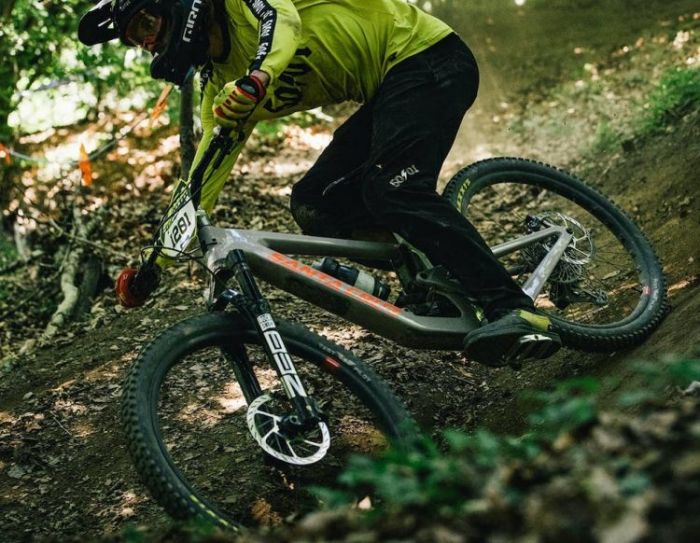Cannondale Trail SE 3
- Price: $1,258
- Travel: 120mm(front)
- Tires: 29 x 2.3″ (front); 29 x 2.25″ (rear)
- Gear: 1×11
What we like about it: The new Smartform C2 alloy frame, combined with the light, responsive Shimano Deore M5100, the RockShox Judy Silver TK 120mm air shock and 29 x 2.3″ front and 29 x 2.25″ rear tires, and most importantly, the delightful price. It is indeed a very suitable choice.
What we don’t like about it: Only one color option is available, which doesn’t reflect the different styles of the riders well.
Rating: (4.7/5)

Cannondale is a professional high-end bike brand with over 50 years of history and many amazing achievements. The Cannondale Trail SE 3 is an affordable and reliable mountain bike. For most riders, the newly designed Smartform C2 alloy frame and the tried and true Shimano Deore M5100 1×11 gears will make it easy and enjoyable to complete your ride. It will make you fall in love with mountain biking and riding.
Below we analysis the Cannondale Trail SE 3’s descent performance, climbing performance, general performance, key features, components and specifications, and other versions.
Cannondale Trail SE 3 Descending Review
For the Cannondale Trail SE 3, a ride more suited to it might be low-impact gravel roads or a leisurely ride. But if you want to try a relatively somewhat aggressive descent once in a while, the 29×2.3″ front tire will give you more consistent support confidence, and grip.
Meanwhile, the RockShox Judy Silver TK, with its 120mm Solo Air shock, is very aggressive in eliminating excess vibration. So the advantage of the air shock being lighter comes into play very clearly. In addition, the head tube angle of less than 66.5° will give me more stable handling.
The Tektro M275 hydraulic discs with 180/160mm rotors always give me the right braking effect during the descent. It has a very linear braking effect, pinching as much braking force as possible, without sudden and vigorous interference or blank travel. The grip also provides a good grip and relieves stress on the wrist and small arm.
Cannondale Trail SE 3 Climbing Review
As I said earlier, the mission of the Cannondale Trail SE 3 is to make you fall in love with the sport of riding and gain more enlightenment. So I didn’t put it through relatively high-intensity climbs. But that doesn’t stop me from sometimes suddenly wanting to take on a challenge like this climb.
Objectively speaking, the 29×2.25″ rear tire may not be its area of expertise in climbing. But the Shimano Deore M5100 1×11 drivetrain gave me a very suitable performance. The shifting was crisp, fast, and fluent on the bigger dirt slopes where quick gearing adjustments were needed, and there was basically no risk of dropping the chain and winding it up.
Experience
First, the innate structural advantage of the hardtail combined with the newly designed Smartform C2 alloy frame and SAVE Micro-Suspension gives me more aggressive climbing and acceleration. It’s rigid and doesn’t let go of force. Due to the thick front and narrow rear tires, I subjectively thought there would be no advantage in climbing. But in reality, this part of the performance is beyond my personal expectations.
Second, it was a more strenuous and intense process as I climbed upward. This makes it impossible for me to pedal standing up all the time. Instead, I would choose to sit in the saddle during some relatively gentle ramps. This is where the ergonomic saddle and the dropper under the saddle give me a very comfortable rest. This is very friendly for long climbs.
More noteworthy is that during the upward climb, the center of gravity is more concentrated on the rear tire. So the FSA alloy riser handlebars are more involved in controlling the balance, allowing me to adjust my stance in time for any situation. Further, the flexible grip provided strong friction for my hands, so I didn’t feel any obvious fatigue even after a long ride.
Overall, based on my riding experience, the Cannondale Trail SE 3 is up to the task of climbing on trails that don’t have particularly gravelly forest roads or hills, and on trails that don’t have particularly steep grades.
General Riding
First of all, because of the positioning of the product, I didn’t do a lot of intense riding on the Cannondale Trail SE 3, more to mimic most people. Mostly I ride it for general commuting and occasionally go to the countryside for some low-intensity experiences.
The previous sharing has shown that it has the strength to handle low to medium-intensity riding. But what I want to convey more is that this is a better bike to ride in everyday life. However, it’s often the small, unnoticeable details that affect daily riding, such as the parts of the bike that touch your body, including the saddle and grips.
Secondly, the proper saddle shape can effectively relieve pressure on the hips and the porous and flexible material can enhance comfort. Both of these things the Cannondale Trail SE 3 does well. What’s even more surprising is that the Cannondale Trail SE 3 is also equipped with a drop bar, which is a pretty direct improvement in comfort in daily driving.
As mentioned earlier, a good grip will ease the strain on your wrists and small arms. If you are out in the countryside at a lake, on a breezy afternoon, the relatively slimmer rear tire will give you more effortless pedaling. Even long rides allow you to enjoy outdoor riding.
It is also compatible with Kick Flip, which can be upgraded to install an invisible bracket. This is really a very convenient piece of equipment for everyday use. In addition, the internal cable routing not only prevents damage caused by wire dragging during intense riding but is also very simple and beautiful in daily use.
Main Features
Frame
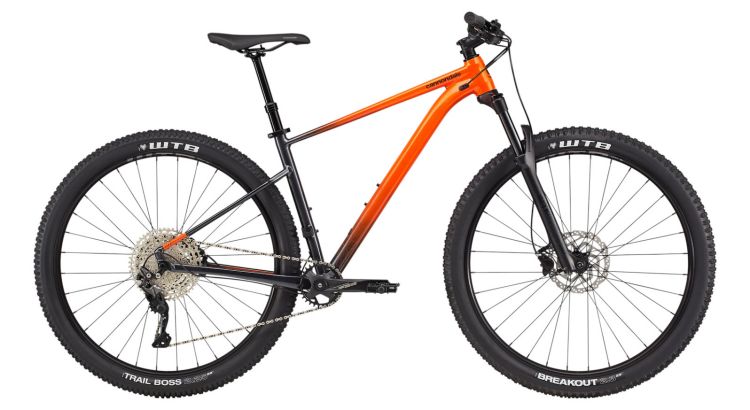
I personally think the new Smartform C2 alloy frame is a great choice compared to the mediocre and expensive carbon frames of ordinary alloys. Because the price is right and the durability is good.
It’s worth noting that the Smartform C2 alloy frame incorporates the latest Trail-ready geometry and dropped seat braces to provide a cleaner shape and more comfortable ride. And it has a lower overall center of gravity and a longer wheelbase, so it’s more stable.
In addition, the rear triangle of the frame has a built-in SAVE Micro-Suspension strategically flexed area. Whether in my descending or climbing, it brings good flexibility in neutral and stability.
In layman’s terms, this Cannondale Trail SE 3 is very easy to handle, which is a great feature.
Geometry
The seat tube angle of the Cannondale Trail SE 3 is different from the fixed seat tube angle of most brands. It is not set in stone but corresponds to the frame size.
This is certainly an extra cost in terms of manufacturing, but the attention to detail reflects the attitude of the Cannondale brand. On my bike, for example, the seat tube angle is 72.6° for the MD size and between 72.5° and 72.7° for the other sizes.
Not only that, but the relatively easy riding angle allows for a comfortable seating position and a good amount of power when reaching for the pedals. No doubt the 66.5° head tube angle is also a smart choice. It will do its job with ease on mildly intense rides or everyday leisurely rides, and won’t be as aggressive as lower models. After all, the product is positioned differently. What also impressed me was the head tube angle. The 66.5° was below average, which really gave me good downhill stability and confidence.
On a side note, there are many factors that affect the riding experience, simply summarized by the bike and the rider itself. If the rider has more strength and skill, it can make up for some of the lack of hardware on the bike itself. Therefore, it is necessary to strengthen your training and improve your athletic ability.
Components and Specifications
RockShox Judy Silver TK Fork
This is the entry-level fork with the latest features and performance. The Judy Silver is also equipped with Motion Control RL dampers, which are compatible with the OneLoc remote control.
In all my actual riding, this shock does its job relatively effectively. It rebounded quickly and supported in place. Especially during my descents, the forward shift of the center of gravity requires a lot of and high load work from the shock. The 120mm air shock was able to defuse it well most of the time.
WTB Breakout (front) and WTB Trail Boss (rear)
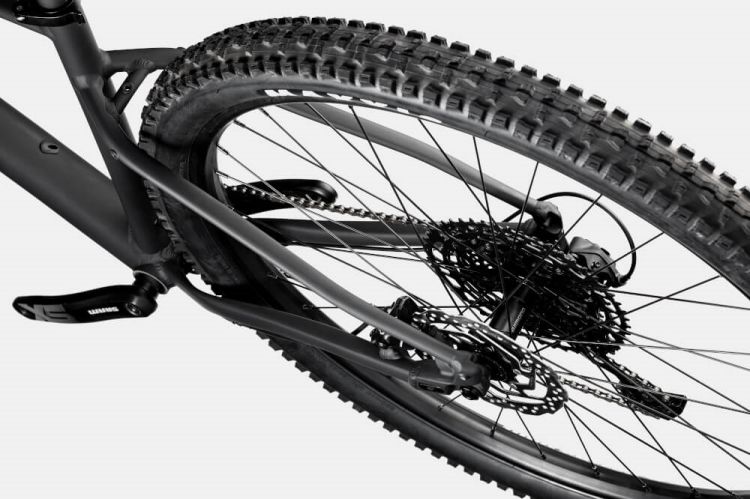
As mentioned earlier, the thick front and thin rear tires make the Cannondale Trail SE 3 more stable on descents. It is also more energy efficient in casual riding.
In addition, the rough tire tread pattern provides a good grip. There is also very little noise during everyday leisure riding. We all know that thicker tires positively dissolve the fine vibrations on the road.
Of course, these advantages in addition to the role of tires, the new frame also plays a small help.
Shimano Deore M5100 1×11 Drivetrain
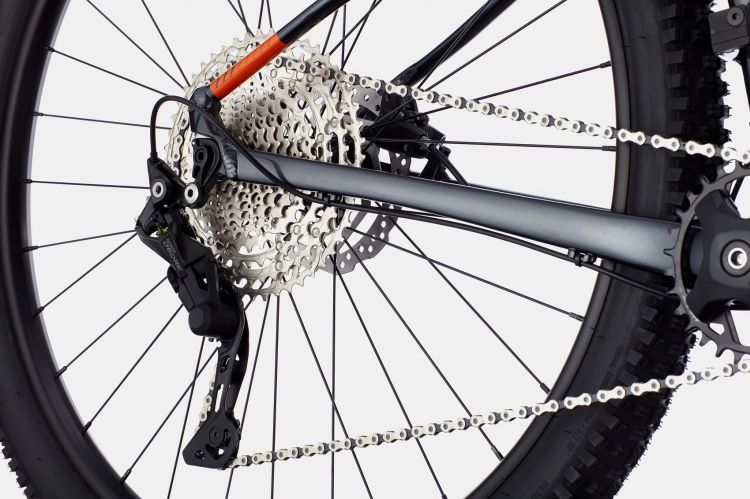
The Shimano Deore M5100 is a drivetrain with a relatively low presence. But low presence doesn’t mean it’s bad. Quite the contrary, I think it has a low failure rate and good durability.
The bottom section is designed to avoid the impact of gravel when passing through the forest road. It is also quiet and smooth in operation. Yet it gives you quick and sensitive feedback when you need to change speed.
It doesn’t have more gears, but that’s perfectly adequate for me.
Tektro M275 Hydraulic Disc
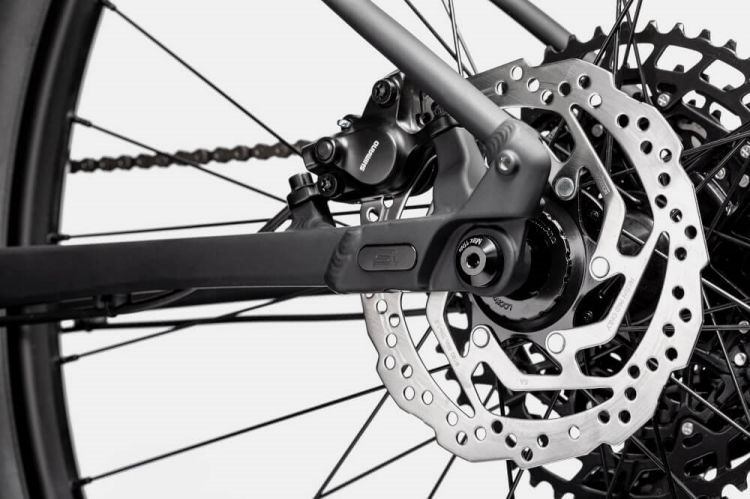
There is no need to talk about the brake hardware, just look at the model number and you will probably know the performance of the brakes. The braking effect is very linear, pinching as much braking force as possible, without sudden and vigorous interference or blank travel. It has enough excellent braking power when descending or climbing, and gentle feedback for everyday riding. That’s how I see this brake, light, powerful, and no fade. That’s the standard of qualified brakes.
Other versions of Trail SE
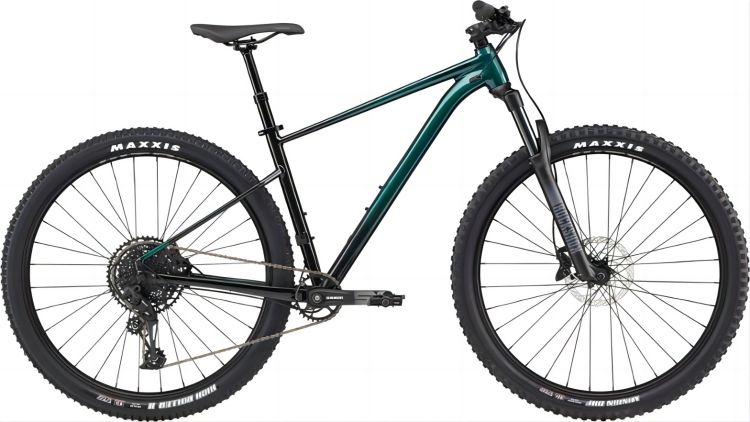
Since the comparison is to be made, the Cannondale Trail SE2, which is more expensive in the same series, is essential.
The Cannondale Trail SE2 is an upgraded version of the Cannondale Trail SE3, with upgraded forks and gears based on the Cannondale Trail SE3. The fork has been upgraded to Rock Shox 35 Silver R with the same 120mm travel as the SE3’s RockShox Judy Silver TK. there is very little difference between the two. If I had to say, I personally feel that the Rock Shox 35 Silver R has a faster rebound. This is my conclusion after repeatedly comparing the two bikes at the same time.
The second upgrade is gearing. Cannondale Trail SE2 is equipped with the SRAM SX Eagle 1×12, which is a gear more suitable for intense garden riding. If you don’t have more intense riding needs, the Cannondale Trail SE3 is a perfectly suitable choice.
The third upgrade is the brakes. The Cannondale Trail SE2 is equipped with TRP Slate G4 4-piston hydraulic discs and 180/160mm rotor brakes. Therefore, the Cannondale Trail SE2 has a softer brake feel than the Trail SE3. Put another way, the four-piston brakes are indeed better.
Learn More: Is the Cannondale Trail SE 2 Worth Buying? [Cannondale Trail 2 Review]
What we like about it?
- A cost-effective choice, the new Smartform C2 alloy frame offers good rigidity.
- Shimano Deore M5100 gears for quiet, smooth use and reliable performance.
- RockShox Judy Silver TK, 120 mm, Solo Air for comfortable daily riding and light-aggressive driving.
- Exquisite workmanship and mountable invisible bracket, internal cable routing, and thoughtful detailing.
- Precise and stable Tektro M275 hydraulic disc braking provides more than enough confidence.
What we don’t like about it?
- There is only one color choice, and it’s an orange color that I don’t particularly like.
- It may be a little boring for people who like excitement.
FAQs
- What is the tire size of the Cannondale Trail SE 3?
WTB Breakout, 29 x 2.3″ / (R) WTB Trail Boss, 29 x 2.25″.
- What are the Cannondale Trail SE 3 brakes?
Tektro M275 hydraulic disc, 180/160mm rotor.
- How do I choose the Cannondale Trail SE 3 size?
Size chart for Cannondale Trail SE 3.
| Size | Rider height |
| SM | 154 – 164 cm |
| MD | 161 – 173 cm |
| LG | 170 – 184 cm |
| XL | 181 – 191 cm |
Cannondale Trail SE 3 Specs
Build
| Frame | All-New, Smartform C2 Alloy, SAVE dropped seat stays, tapered headtube, post mount disc, StraightShot internal cable routing, dropper post compatible BSA 73, 12mm thru-axle, Boost 148 BB Standard: BSA, 73mm, Threaded Color: Impact Orange |
| Fork | RockShox Judy Silver TK, 120mm, Solo Air, 15×110 thru-axle, 51mm offset |
| Bottom Bracket | Sealed cartridge bearing, square taper |
| Headset | Integrated Sealed Bearing, Tapered |
| Stem | Cannondale, 6061 Alloy, 31.8, 7° |
| Handlebar | FSA Alloy Riser, 15mm rise, 760mm |
| Saddle | Cannondale Ergo XC |
| Seatpost | TranzX Dropper, 31.6, Internal Routing, 100mm (S), 120mm (M-XL) |
| Pedals | Cannondale Platform |
| Grips | Cannondale Locking Grips |
Groupset
| Rear Derailleur | Shimano Deore M5100 |
| Crank | FSA Alpha Drive, 30T |
| Shifters | Shimano Deore M5100, 11-speed |
| Cassette | Shimano Deore M5100, 11-51, 11-speed |
| Chain | KMC X11, 11-speed |
| Brakes | Tektro M275 hydraulic disc, 180/160mm rotors |
| Brake Levers | Tektro hydraulic disc |
Wheels
| Rims | WTB STX i25 TCS, 32h, tubeless ready |
| Spokes | Stainless Steel, 14g |
| Front Hub | Shimano MT400, 15x110mm thru-axle |
| Rear Hub | Shimano MT400 12×148 |
| Tires | (F) WTB Breakout, 29 x 2.3″ / (R) WTB Trail Boss, 29 x 2.25″ |
Video
Comparison Table
| Bicycles | Price | Gear | Brakes | Tires | Click view |
| Marin Pine Mountain 1 | $1499 | 1×11 | Shimano MT400 Hydraulic Disc | 29×2.6″ | Click view |
| Vitus Sentier 27 VR Mountain | $1243.23 | 1×11 | Shimano Deore MT410 or Clarks M4, Post Mount, Shimano: Two Piston Caliper, Clarks: Four Piston Caliper | 27.5 x2.6 “ | Click view |
| Salsa Rangefinder Deore 11 27.5+ | $1549 | 1×11 | Shimano MT200 Hydraulic Disc or Promax DSK-925 Hydraulic Disc | 27.5 x 2.8″ | Click view |
| Giant Stance 29 2 | $1800 | 1×10 | Tektro HD M745 Hydraulic Disc | 29×2.35 “ | Click view |
Marin Pine Mountain 1 vs Cannondale Trail SE 3
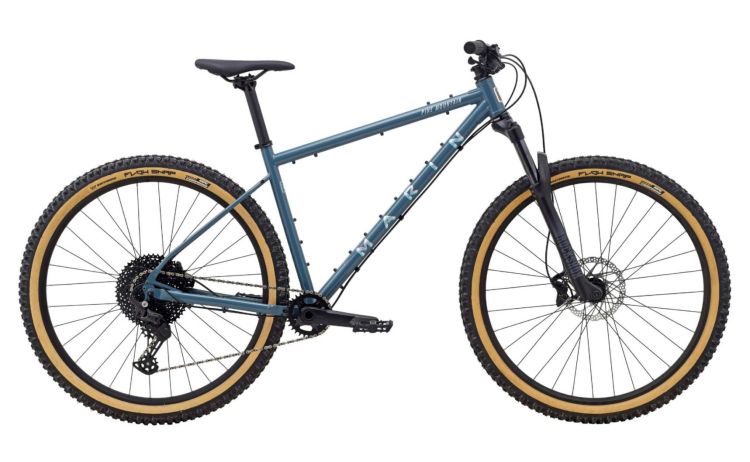
The first time I saw Marin Pine Mountain 1 I was attracted by its color, which is indeed very fresh. And the tires are not just black, they have yellow trim rings. So the whole thing has a lively feeling, and I have to say that color has a great influence on people.
But subjective emotions aside, these two cars are basically at the same level of hardware configuration, except that the Cannondale Trail SE 3 has an extra drop tail. Marin Pine Mountain 1, on the other hand, does not have this feature. The drop tail does feel better in many riding experiences, and the price is almost $250 cheaper than the Marin Pine Mountain 1. So back to reason, I personally think the Cannondale Trail SE 3 is the better choice. Of course, if you care more about looks, the Pine Mountain 1 is also a good idea.
If your riding environment is more urban, the beautiful shape of the Marin Pine Mountain 1 is sure to attract more attention. But if your riding scenario is more diverse, the Cannondale Trail SE 3’s richer configuration is certainly a more suitable choice.
Learn more : Is Marin Bolinas Ridge 1 A Perfect Selection? – [Marin Bolinas Ridge 1 Review]
Vitus Sentier 27 VR Mountain vs Cannondale Trail SE 3
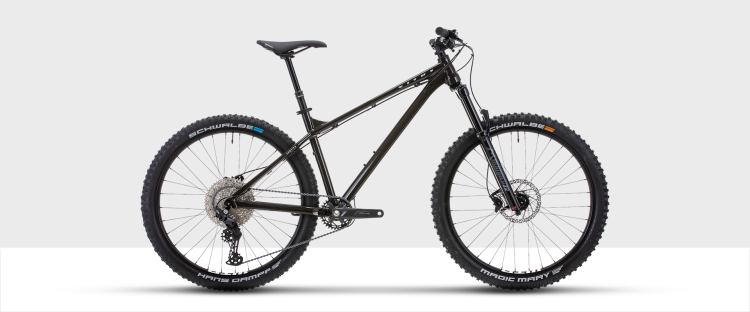
The Vitus Sentier 27 VR is a bike with a lot of character, and the choice between it and the Cannondale Trail SE 3 seems pretty simple to me. It has a more compact frame and relatively small tires, as well as better agility. It’s much more addictive on both climbs and descents.
Again, it’s not its main battleground in daily commuting scenarios. The aggressive riding geometry isn’t as comfortable as the Cannondale Trail SE 3. So, if you want a more pure mountain riding experience, go with the Vitus Sentier 27 VR. But if you want a leisurely ride with some low to moderate-intensity mountain riding, the Cannondale Trail SE 3 is definitely a better partner.
Learn more : Is Vitus Sentier 29 VRX Splendid? – [ Vitus Sentier 29 VRX Review ]
Salsa Rangefinder Deore 11 27.5+ vs Cannondale Trail SE 3
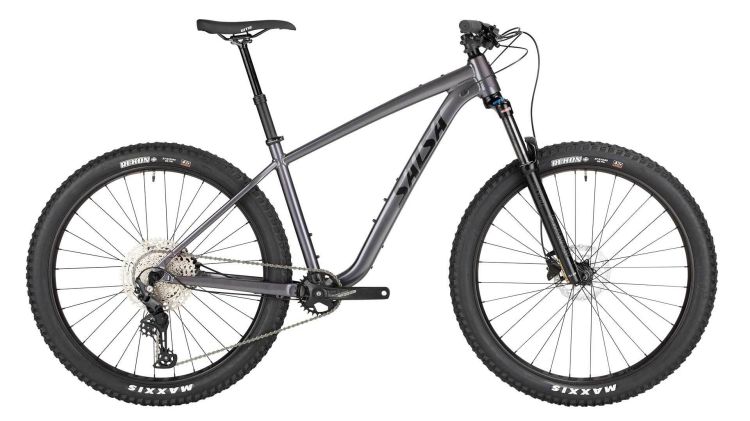
The comparison of these two bikes is also relatively simple in my opinion, as they are very different in style.
The Salsa Rangefinder Deore 11 27.5+ is equipped with 27.5 tires. But it’s 2.8 wide, which means it’s smaller and thicker than the Cannondale Trail SE 3’s 29 x 2.3 front and 29 x 2.25 rear tires. Combined with Salsa’s mountain bike expertise, this Salsa Rangefinder Deore 11 27.5 has a more professional performance in the mountain woods. The Salsa Rangefinder Deore 11 27.5+ is undoubtedly the professional version of the Salsa Sentier 27 VR Mountain when understood in the context of the previous models compared.
Also, the Salsa Rangefinder Deore 11 27.5+ is almost $300 more expensive than the Cannondale Trail SE 3. In addition, there is a big difference in the applicable scenarios.
So to sum up, if your usage scenarios are more lifestyle and diverse, the Cannondale Trail SE 3 is a good choice. Conversely, if you like more exciting adventures in the woods, the Salsa Rangefinder Deore 11 27.5 is waving at you.
Giant Stance 29 2 vs Cannondale Trail SE 3
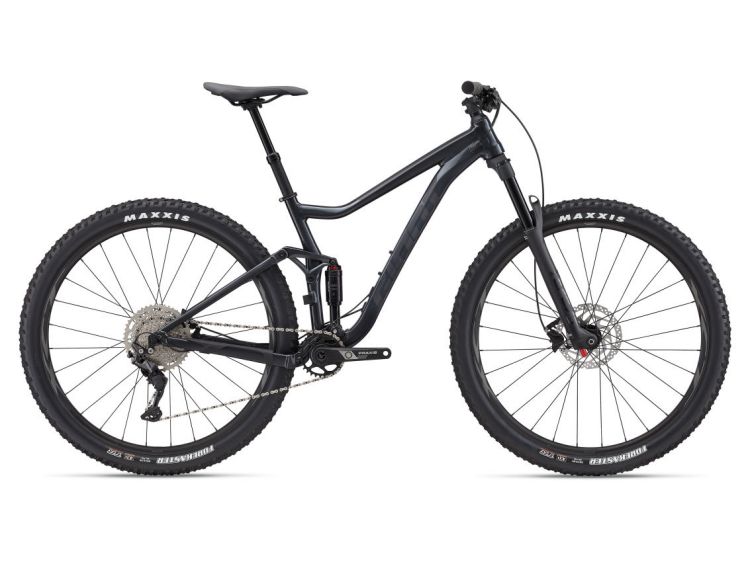
The Giant Stance 29 2 is a full-suspension mountain bike with 130mm of front and 120mm of rear travel, the Shimano Deore M5120 has 10-speed gears and droppers, and is ready for vacuum tires. To be honest, the Giant Stance 29 2 and Cannondale Trail SE 3 are not at all the same type of product. There is a big difference in both price range and usage scenarios.
My recommendation is that if you are a daily commuter, including commuting to and from work or school or the occasional countryside ride, then go for the Cannondale Trail SE 3. I believe it will be your reliable friend. But if you want to take on the hills and woods, is a better choice than the Giant Stance 29 2.
In case, the above comments are helpful to you, please remember to share the subscription. Have a great day!
learn more:Giant Stance Review – Finding The Joy Of Riding In A Rapid Descent

![[Orbea URRUN 10 20mph Review] – Best Used By People Who Enjoy Riding To Get AFeel For The Mountains!](https://bestbikeselect.com/wp-content/uploads/2023/09/2023-Orbea-URRUN-10-20mph-35_-1024x1024.jpg)
![[Specialized Turbo Como 5.0 Review] – Good Choice?](https://bestbikeselect.com/wp-content/uploads/2023/08/2023-Specialized-Turbo-Como-5.01_-1024x1024.webp)
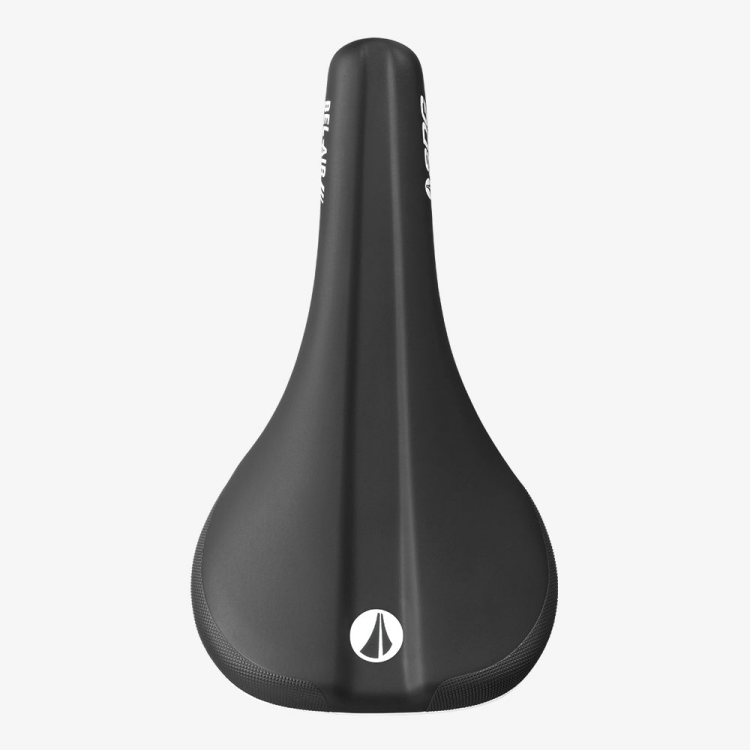
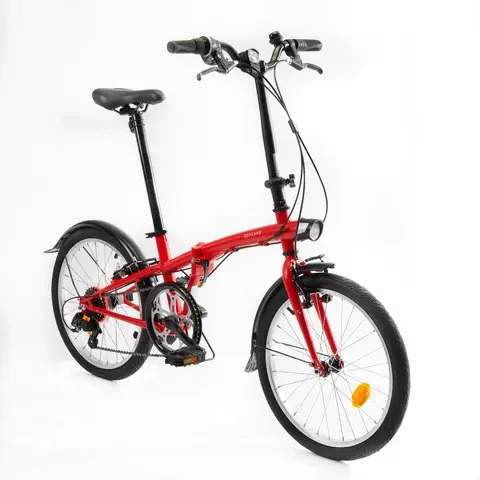
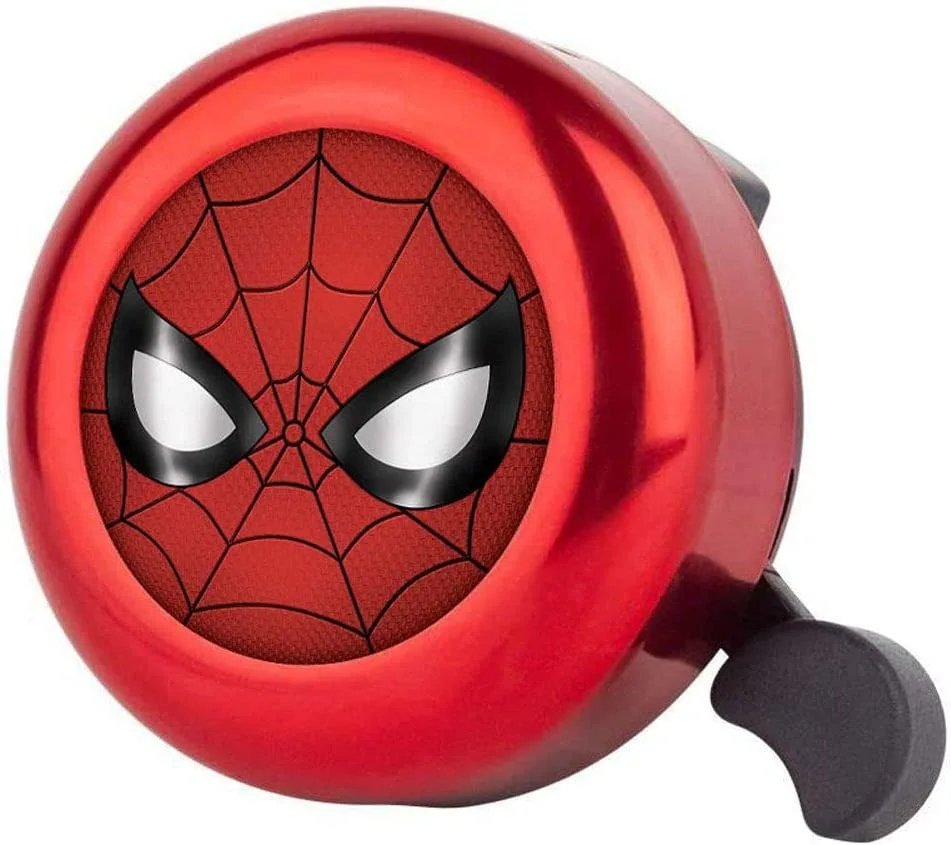
![2025 Built for Champions:[Orbea ORCA M21eTEAM PWR Review]](https://bestbikeselect.com/wp-content/uploads/2025/01/ORCA-M21eTEAM-PWR-1024x885.jpg)
![2025 Conquer Any Trail [Santa Cruz Bronson R Review]](https://bestbikeselect.com/wp-content/uploads/2025/01/Santa-Cruz-Bronson-R-1-1024x768.webp)
![2025 The All-Terrain Beast [Santa Cruz Hightower 3 MY24 Review]](https://bestbikeselect.com/wp-content/uploads/2025/01/Santa-Cruz-Hightower-3-MY24-1024x768.webp)
![The Best Comfortable Leisure Bike of 2025 [ Trek Verve 2 Lowstep Gen 5 ]](https://bestbikeselect.com/wp-content/uploads/2024/12/Verve-2-Lowstep-Gen-5-02-1024x681.png)
![2025’s Top Endurance Bikes [Cannondale Synapse Carbon 3 L Review]](https://bestbikeselect.com/wp-content/uploads/2025/01/Cannondale-Synapse-Carbon-3-L-1-1024x627.webp)
